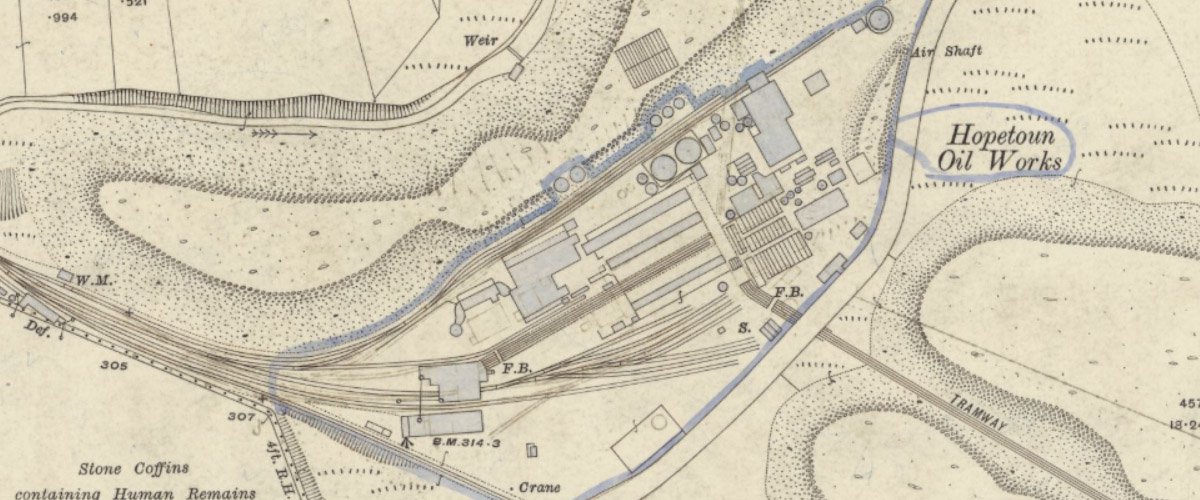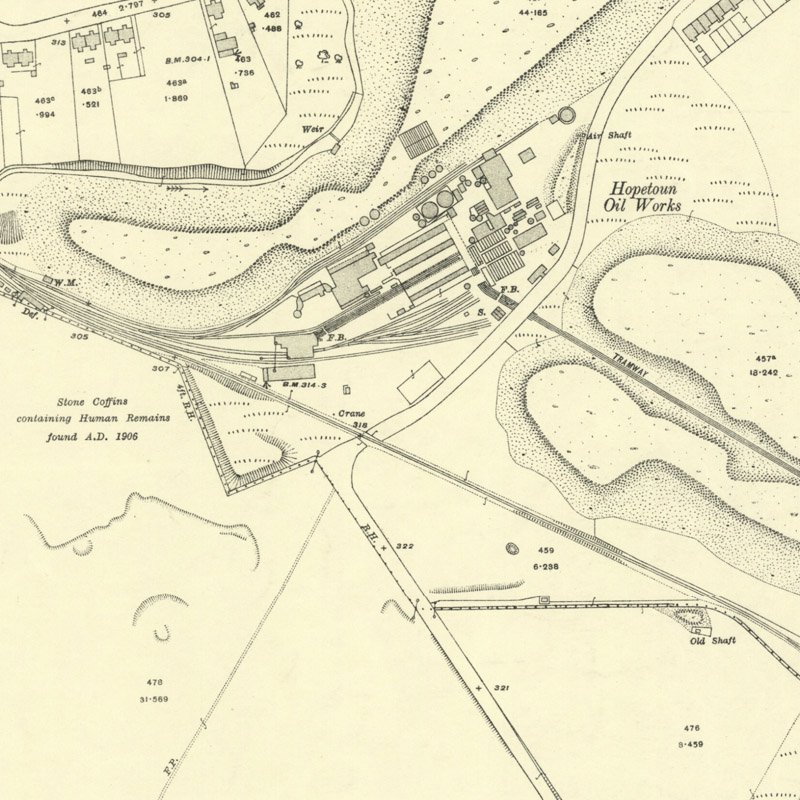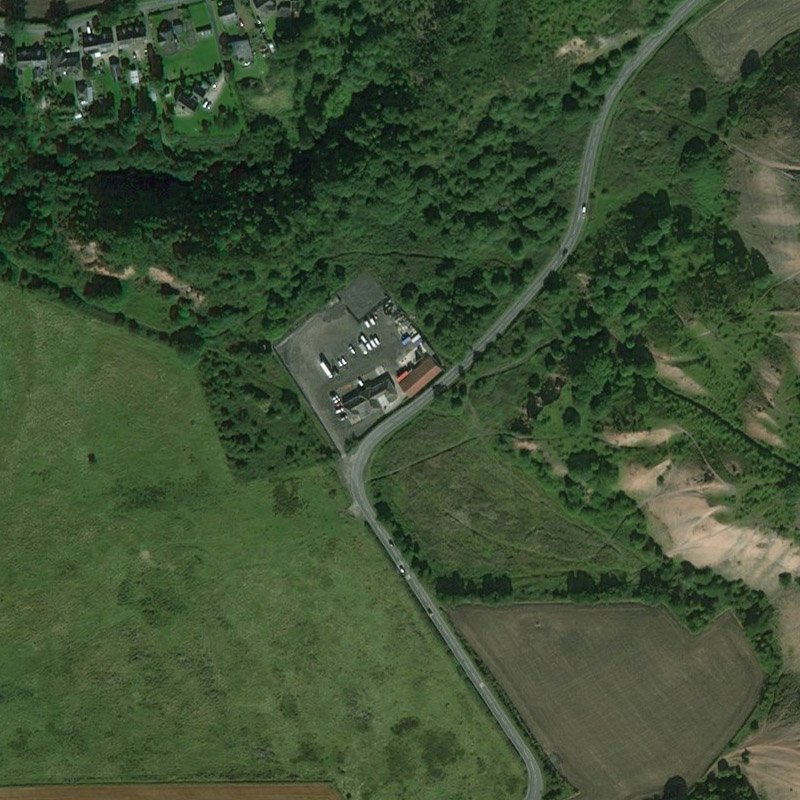- Aberdeen Oil Works
- Addiewell Oil Works
- Almondhill Oil Works
- Annick Lodge Oil Works
- Arden Oil Works
- Armadale Oil Works
- Auchenheath Oil Works
- Avonhead Oil Works
- Balgray Oil Works
- Ballat Oil Works
- Bathgate Oil Works
- Bathville Oil Works
- Bellsdyke Oil Works
- Bellsquarry Oil Works
- Benhar Oil Works
- Binnend Oil Works
- Birkenshaw Oil Works
- Bishop Street Oil Works
- Blackburn Oil Works
- Blackstone Oil Works
- Blackstoun Oil Works
- Blochairn Oil Works
- Boghall Oil Works
- Bredisholm Oil Works
- Breich Oil Works
- British Asphalte Oil Works
- Broxburn Oil Works
- Broxburn - Bell's Stewartfield Oil Works
- Broxburn - Albyn Oil Works
- Broxburn - East Mains Oil Works
- Broxburn - Greendykes Oil Works
- Broxburn - Hallfarm Oil Works
- Broxburn - Hutchinson's Oil Works
- Broxburn - Poynter's Oil Works
- Broxburn - Steele's Oil Works
- Broxburn - Steele's Stewartfield Oil Works
- Buckside Oil Works
- Burngrange Oil Works
- Calderbank Oil Works
- Canalbank Oil Works
- Champfleurie Oil Works
- Clippens Oil Works
- Cobbinshaw North Oil Works
- Cobbinshaw South Oil Works
- Coneypark Oil Works
- Craigie Oil Works
- Crown Point Oil Works
- Dalmeny Oil Works
- Deans Oil Works
- Doura Oil Works
- Drumbow Oil Works
- Drumcross Oil Works
- Drumgray Oil Works
- Dryflat Oil Works
- East Fulton Oil Works
- East Hermand Oil Works
- Eldin Oil Works
- Falkirk Oil Works
- Fergushill Oil Works
- Forthbank Oil Works
- Forth & Clyde Oil Works
- Gavieside Oil Works
- Grange Oil Works
- Grangepans Oil Works
- Greengairs Oil Works
- Hareshaw Oil Works
- Hartwood Oil Works
- Hawick Oil Works
- Hermand Oil Works (1866)
- Hermand Oil Works (1883)
- Holmes Oil Works
- Hopetoun Oil Works
- Hurlford Oil Works
- Inkerman Oil Works
- Inverkeithing Oil Works
- Kilrenny Oil Works
- Kilwinning Oil Works
- Kirkmuirhill Oil Works
- Kirkwood Oil Works
- Lanark Oil Works
- Lanemark Oil Works
- Levenseat Oil Works
- Limerigg Oil Works
- Linwood Oil Works
- Loanhead Oil Works
- Lochburn Road Oil Works
- Lochgelly Oil Works
- Longrigg Oil Works
- Magdalene Oil Works
- Methil Oil Works
- Millburn Oil Works
- Nettlehole Oil Works
- Niddry Castle Oil Works
- Nitshill Oil Works
- Oakbank Oil Works
- Palacecraig Oil Works
- Pathhead Oil Works
- Patterton Oil Works
- Pentland Oil Works
- Philpstoun Oil Works
- Port Dundas Oil Works
- Possil Oil Works
- Pumpherston Oil Works
- Raebog Oil Works
- Riggend Oil Works
- Rochsoles Oil Works
- Rochsolloch Oil Works
- Roman Camp - Almondfield Oil Works
- Roman Camp - Cawburn Oil Works
- Roman Camp Oil Works (1892)
- Roman Camp - Shale Oil Works
- Rosebank Oil Works
- Roughcraig Oil Works
- Rumford Street Oil Works
- Seafield Oil Works
- Shawsburn Oil Works
- Sheepford Locks Oil Works
- Shettleston Oil Works
- Shotts Oil Works
- Stand Oil Works
- Stanrigg Oil Works
- Stonehouse Oil Works
- Straiton Oil Works
- St. Rollox Works
- Swinehill Oil Works
- Tarbrax Oil Works
- Uphall Oil Works
- Uphall - Railway Oil Works
- Uphall - Wyllie's Oil Works
- Vulcan Chemical Works
- Wardend Oil Works
- Wattston Oil Works
- Westfield & Capeldrae Oil Works
- Westwood Oil Works (1941)
- Westwood Oil Works (1866)
- Whitebog Oil Works
- Whitehill Oil Works (Lanarkshire)
- Whitehill Oil Works (Midlothian)
- Whiterigg Oil Works
- Woodhall Oil Works
Hopetoun Oil Works
Hopetoun Oil Works operated for a longer period than any other crude oil works in Scotland. It was one of three oil works established by the Uphall Mineral Oil Company Ltd, and supplied crude oil to their Uphall Refinery by means of a circuitous railway line from Uphall (built 1886) that also served the company's Forkneuk pits. The works were initially supplied by Hopetoun No. 1 and Hopetoun No. 2 shale pits, adjacent to the works and subsequently by Hopetoun No. 3 mine which lay to the south east. The company constructed housing for most of the workforce in Niddry Rows.
Amalgamation of the Uphall Oil Company Ltd with Young's Paraffin Light & Mineral Oil Company Ltd in 1883 led to new investment in Hopetoun Oil Works and the replacement of the last of the vertical retorts originally used there. New mines were sunk to the north and west of the works served by a mineral railway that eventually extended as far as Fawnspark, close to Philpstoun.
The works were substantially rebuilt in about 1906 and new retorts installed. A substantial album of photographs records this construction work in progress (LVSAV2009.028). Having exhausted available space to dump spent shale in the vicinity of the works, a haulage was constructed as part of these modernisation works, passing beneath the Greendykes to Winchburgh road to a new tip south of the works. This bing was subsequently extended eastward, placing Niddry Rows in continual shadow, and ultimately formed a continuous mass with the Broxburn Oil Company Ltd's Albyn bing.
The works were closed in 1948 and demolished in c.1952.
| Date | Rateable Value | Owner | Occupier | Notes |
|---|---|---|---|---|
| 1872 | Uphall Mineral Oil Company Ltd | Uphall Mineral Oil Company Ltd | Works unfinished | |
| 1873-74 | £573.5/- | Uphall Mineral Oil Company Ltd | Uphall Mineral Oil Company Ltd | |
| 1875-76 | £504 | Uphall Mineral Oil Company Ltd | Uphall Mineral Oil Company Ltd | |
| 1877-82 | £650 | Uphall Oil Company Ltd | Uphall Oil Company Ltd | |
| 1883 | £850 | Uphall Oil Company Ltd | Uphall Oil Company Ltd | |
| 1884 | £832 | Young's Paraffin Light & Mineral | Young's Paraffin Light & Mineral | |
| 1885-88 | £850 | Young's Paraffin Light & Mineral | Young's Paraffin Light & Mineral | |
| 1889 | £1250 | Young's Paraffin Light & Mineral | Young's Paraffin Light & Mineral | |
| 1890 | £1550 | Young's Paraffin Light & Mineral | Young's Paraffin Light & Mineral | |
| 1891-92 | £1575 | Young's Paraffin Light & Mineral | Young's Paraffin Light & Mineral | |
| 1893 | £1420 | Young's Paraffin Light & Mineral | Young's Paraffin Light & Mineral | |
| 1894-1900 | £1800 | Young's Paraffin Light & Mineral | Young's Paraffin Light & Mineral | |
| 1901 | £4625 | Young's Paraffin Light & Mineral | Young's Paraffin Light & Mineral | |
| 1902-06 | £2800 | Young's Paraffin Light & Mineral | Young's Paraffin Light & Mineral | |
| 1907-13 | £4500 | Young's Paraffin Light & Mineral | Young's Paraffin Light & Mineral | |
| 1914-27 | £3700 | Young's Paraffin Light & Mineral | Young's Paraffin Light & Mineral | |
| 1928 | £3145 | Young's Paraffin Light & Mineral | Young's Paraffin Light & Mineral | |
| 1929-35 | £3700 | Young's Paraffin Light & Mineral | Young's Paraffin Light & Mineral | |
| 1936-38 | £3760 | Young's Paraffin Light & Mineral | Young's Paraffin Light & Mineral | |
| 1939 | £3917 | Young's Paraffin Light & Mineral | Young's Paraffin Light & Mineral | |
| 1940 | £3924 | Young's Paraffin Light & Mineral | Young's Paraffin Light & Mineral | |
| 1941 | £3774 | Young's Paraffin Light & Mineral | Young's Paraffin Light & Mineral | |
| 1942-43 | £3762 | Young's Paraffin Light & Mineral | Young's Paraffin Light & Mineral | |
| 1944-45 | £3746 | Young's Paraffin Light & Mineral | Young's Paraffin Light & Mineral | |
| 1946-47 | £3765 | Young's Paraffin Light & Mineral | Young's Paraffin Light & Mineral | |
| 1948 | £200 | Young's Paraffin Light & Mineral | Young's Paraffin Light & Mineral | |
| 1949 | £50 | Young's Paraffin Light & Mineral | Young's Paraffin Light & Mineral | |
| 1950-51 | £50 | Young's Paraffin Light & Mineral | Young's Paraffin Light & Mineral | |
| NO FURTHER ENTRIES |
Archive images

See full record, LVSAV2010.039.004

See full record, LVSAV2010.039.005
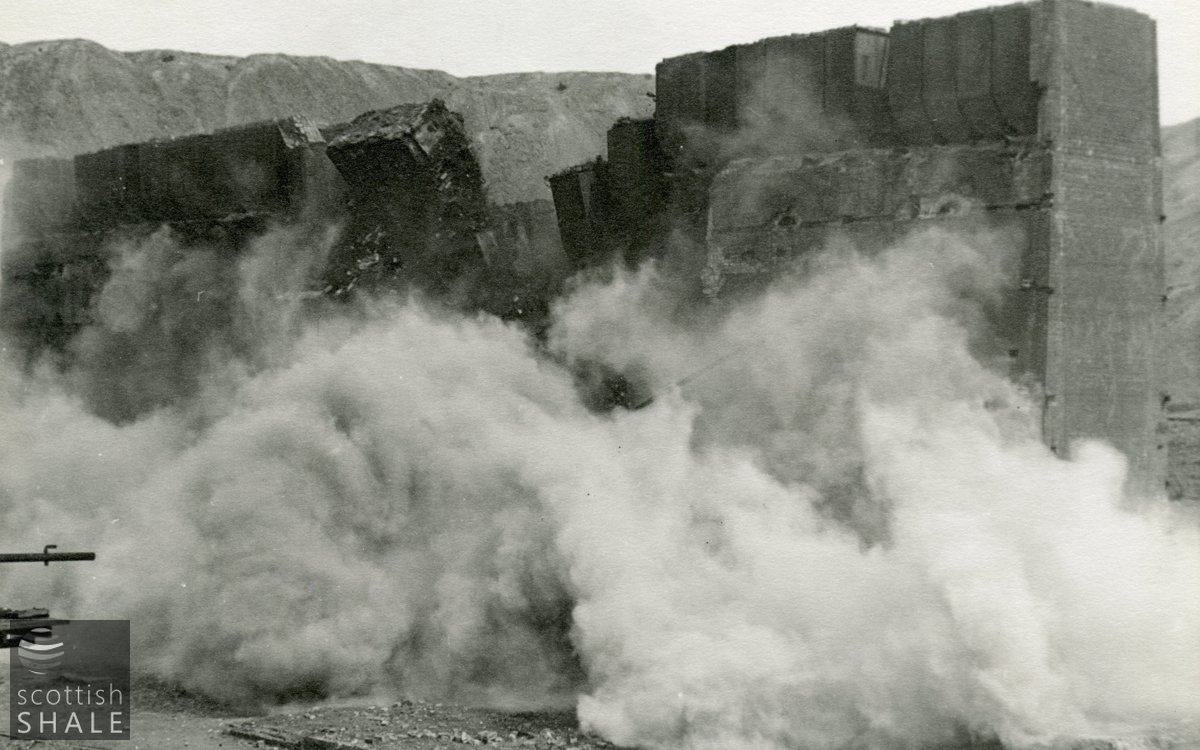
See full record, LVSAV2010.039.006
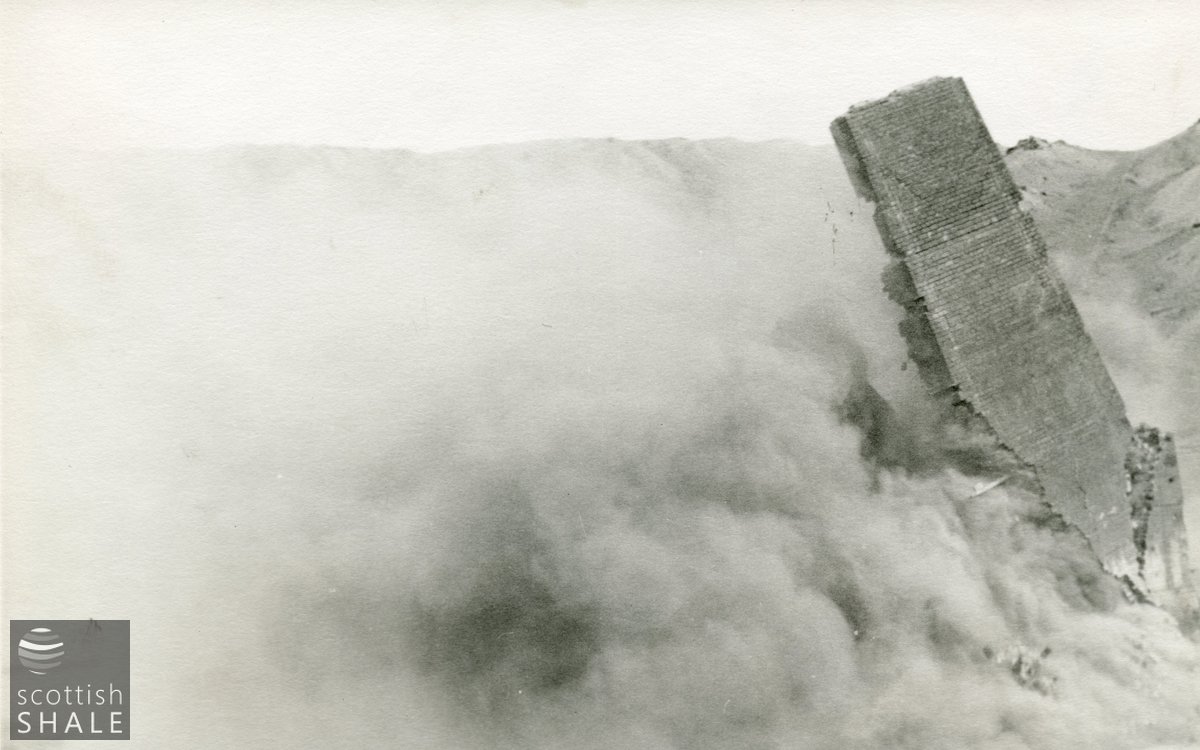
See full record, LVSAV2010.039.007
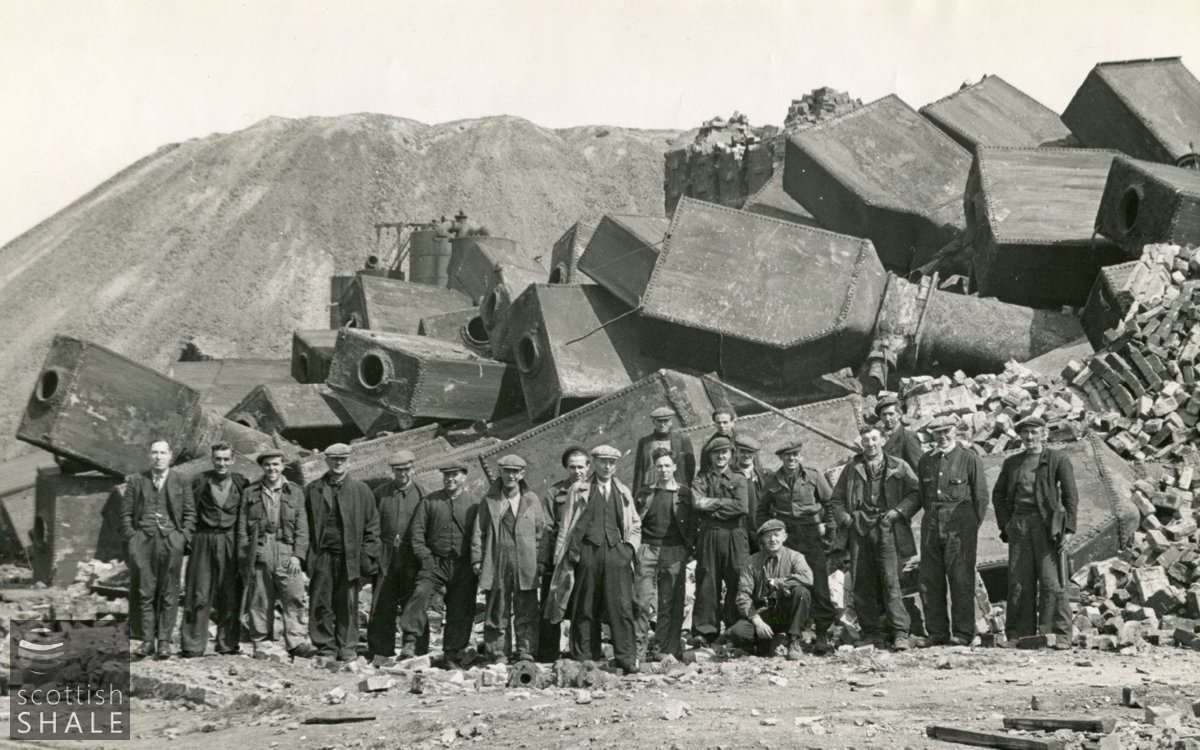
See full record, LVSAV2010.039.009

See full record, LVSAV2010.039.010
The Hopetoun Bings
Spent shale from Hopetoun oil works seems initially to have been tipped to the west of the works, up to a boundary formed by the Niddry burn and the mineral railway that served the works. By 1894, when the second edition OS map was surveyed, waste was being tipped to the north and east of the works, already having buried the site of the first Niddry shale pits, with tipping operations increasingly hemmed in between the Niddry burn and Niddry village. In 1906, the oil works were reconstructed and a new bridge installed beneath the railway to a new tipping site south of the Niddry road.
The 1914 map shows that every part of the land north of the road had been used for tipping, with the course of the Niddry burn diverted in some places. The Hopetoun south bing already extended a considerable distance, with tipping taking place from stepped platforms on either side of the haulage route. As the 20th century progressed, the bing reached its full height, and then the tipping from the bing top extended north eastwards towards the village of Niddry, which lay in a progressively narrowing canyon between the north and south bings.
When the mineral railway between Hopetoun and Broxburn works was closed following the closure of Broxburn works in 1926, it became possible to extend the Hopetoun south bing towards the south. Eventually Hopetoun south bing meet and merged with the bing that extended north from Broxburn oil works, forming a long continuous plateau . This mountain of spent shale is now known as the Greendykes bing and (along with Hopetoun North bing) is now protected as an ancient monument.
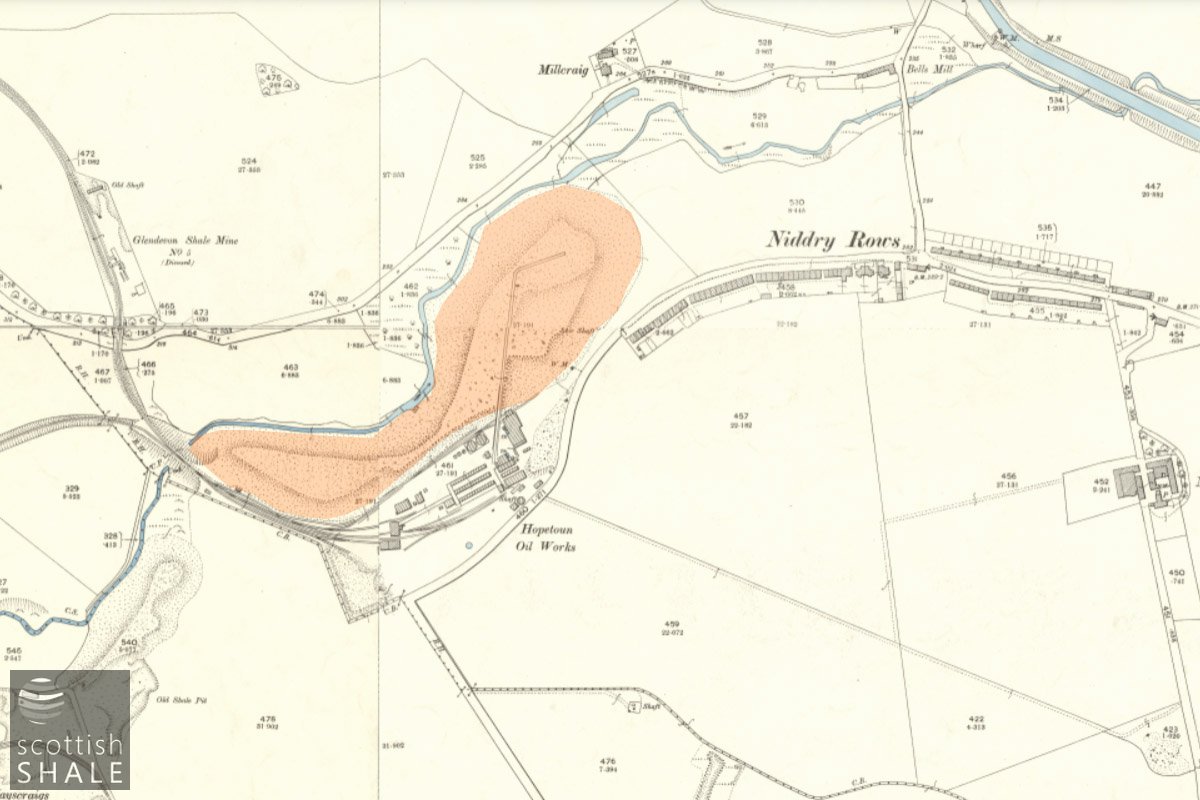
25" OS map c.1896., courtesy National Library of Scotland
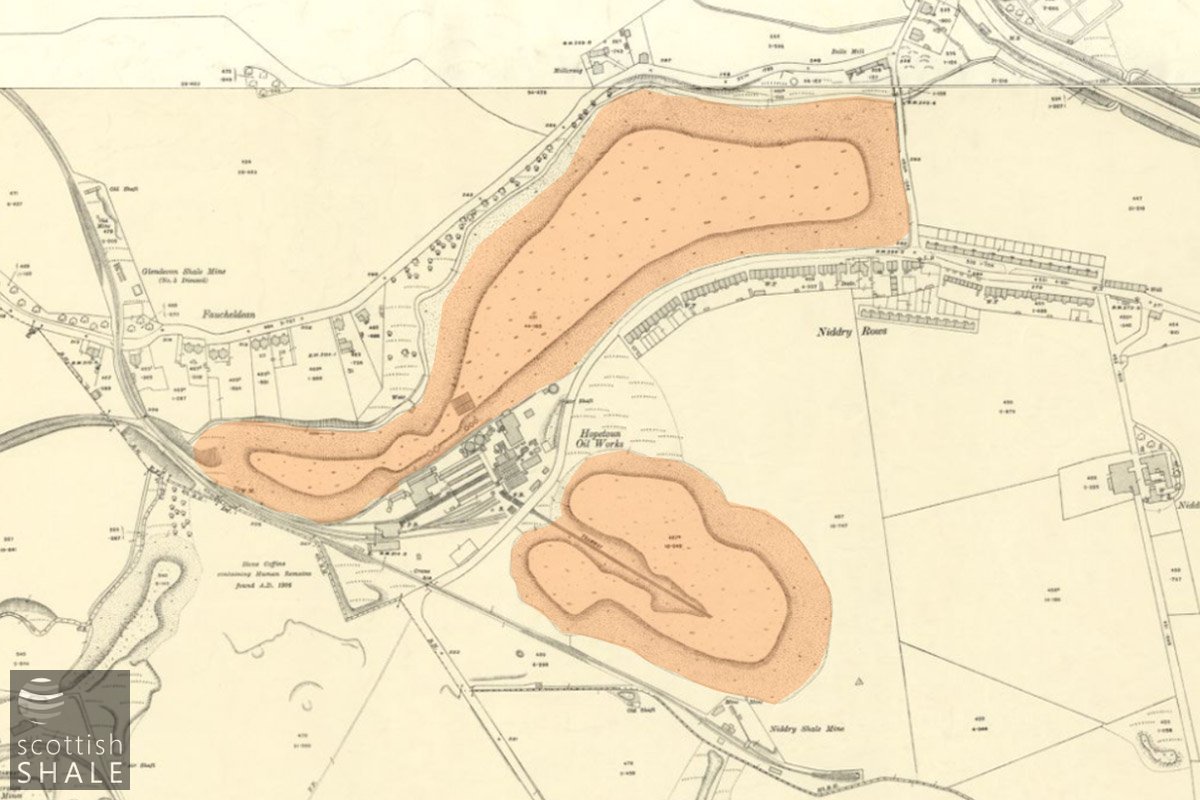
25" OS map c.1914., courtesy National Library of Scotland

1:2500 OS map c.1958., courtesy National Library of Scotland
Recent images
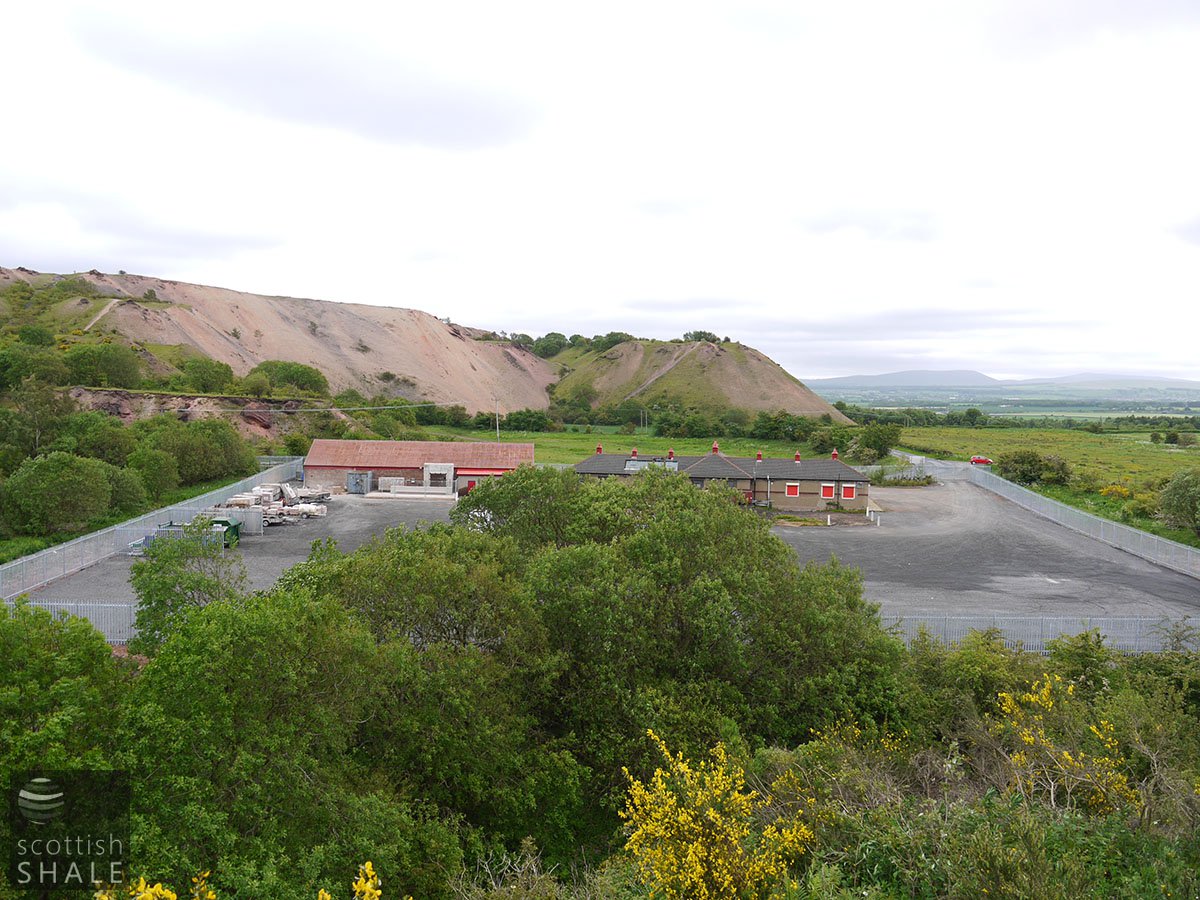
View from original bing, across site of the oil works toward the new bing. Looking south east. June 2011.

View across site of retorts. Looking east. June 2011.
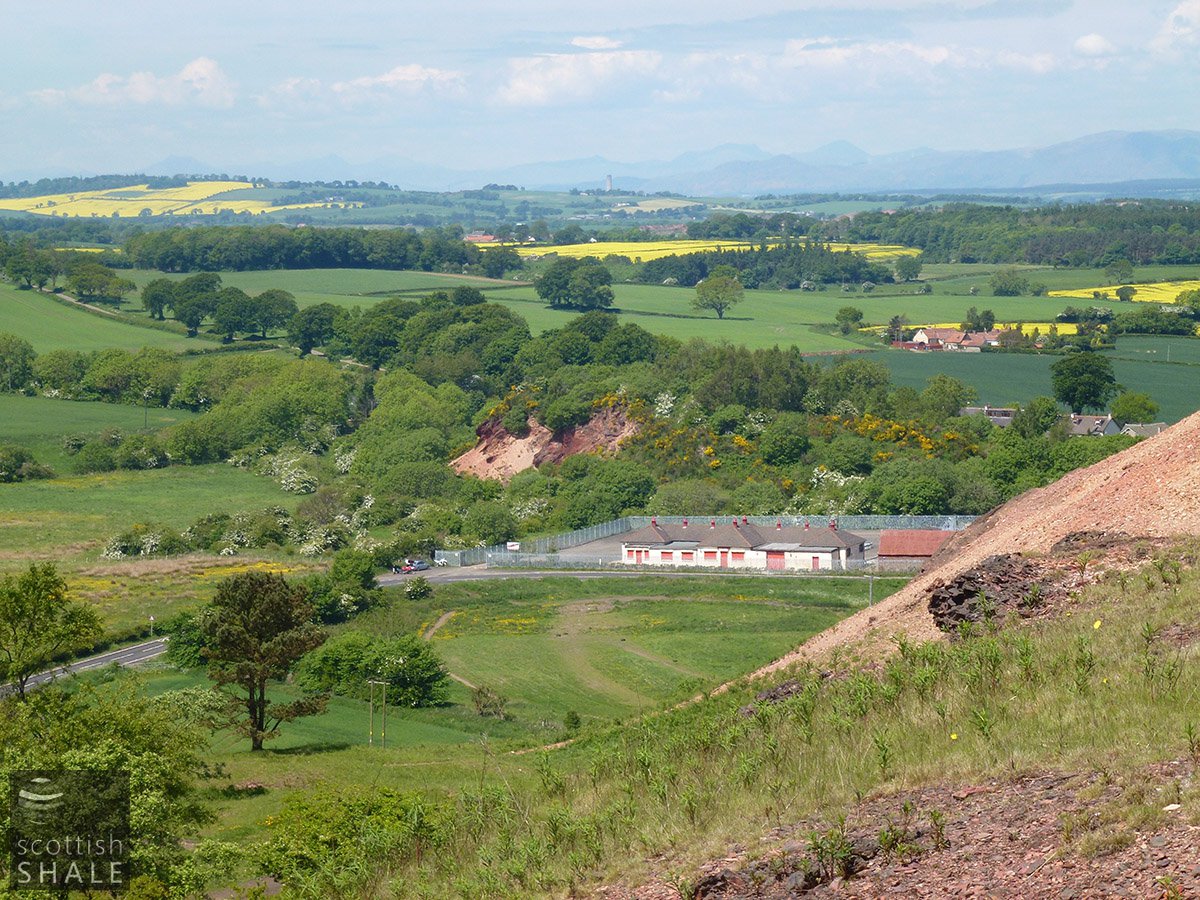
8th June 2013
At Hopetoun the vertical retorts were stopped last month; and now the company's retort plant is all of the most modern and approved description, consisting entirely of the Pentland and Henderson retorts, the two best which have been yet devised.
AGM of Young's Paraffin Light & Mineral Oil Company Ltd reported in Glasgow Herald, 18th June 1885
.......
HOPETOUN OIL WORKS.
Operations are going on apace in connection with alterations at Hopetoun Oil Works. Quite a number of labourers are engaged making the haulage road for the new spent shale bing, and it is expected that a new bench of retorts will soon be ready.
West Lothian Courier, 30th November 1906
.......
Young's Company is making rapid progress with its extension of plant at Hopetoun, Niddry. Mining operations have begun and a new mineral railway to Niddry will soon be busy.
West Lothian Courier, 15th March 1907
.......
BOON TO OIL WORKERS
A further step to improve the working conditions of their employees was taken by the Scottish Oils Limited, when new workmen's baths were opened at the Hopetoun Oil Works, Niddry, West Lothian. The baths are fitted with sprays in 160 cubicles, and a mess room and ambulance room. Seventy-live per cent of the workers used the baths during the first day. The innovation costs 4d per week to those workers over 21 and 3d to others.
Midlothian Advertiser 28th April 1939
.......
OPENING OF NEW BATHS AT NIDDRY.
The Scottish Oil Coy., Ltd., have been supplying their workers all over the area with baths, and last week the subsidiary company. Hopetoun Oil Co., opened their baths at Niddry. These baths are situated near the works, and from them beautiful view may be obtained of the surrounding countryside. At one time the Rows were in the immediate vicinity, but demolition has taken place, and the populace has been housed in the new housing scheme at Millgate. They are similar to the baths recently erected at Winchburgh. and should prove as great a boon to the workers, who are taking full advantage of them. When the men arrive for their work, they place their clothes in a locker's and don suitable working garments. When they return at the end of their shift their clothes are placed in another locker, and they proceed to cubicle, which has spray at different temperatures. A system of heating has been introduced, which dries the clothes in the locker. The foremen, if they so desire, can indulge in a hot bath, as two large baths have been installed. For those who reside at a distance, there is a large room with seating accommodation, where the men may take their mid-day meal. In case of accident there an ambulance room fitted with the necessary equipment, and the company, in making the various appointments to the baths, have engaged men with ambulance experience. The weekly cost to the workers is fourpence, and to the boys threepence.
Linlithgowshire Gazette, 19th May 1939
- 195295 - Minute of Agreement between the County Council of Linlithgow and Young's Paraffin Light and Mineral Oil Company Limited and the Marquis of Linlithgow - Minute of Agreement between the County Council of Linlithgow and Young's Paraffin Light and Mineral Oil Company Limited and the Marquis of Linlithgow dated 1906. Includes signature of Hugh Brown, director of Young's Paraffin Light and Mineral Oil Company Limited. Includes undated plan of area referred to in the agreement, Hopetoun Works, with the centre line of proposed motorway indicated in red and a cross section of the area. Horizontal scale: 1"=20' Vertical scale: 1"=10'
- LVSAV2010.039 - Photo - Demolition of Retorts at Hopetoun Oil Works c.1952 - Black and white photograph shows the rubble of the demolished retort, with some men walking in the foreground
- LVSAV2010.039 - Photo - Demolition of Retorts at Hopetoun Oil Works c.1952 - Black and white photograph shows the staff standing in front of the rubble of the demolished retort. George Reid, Manager of the Hopetoun Oil Works, is in the centre of the group
- LVSAV2010.039 - Photo - Demolition of Retorts at Hopetoun Oil Works c.1952 - Black and white photograph shows the staff standing in front of the rubble of the demolished retort. George Reid, Manager of the Hopetoun Oil Works, is in the centre of the group
- LVSAV2010.039 - Photo - Demolition of Retorts at Hopetoun Oil Works c.1952 - Black and white photograph shows the retort mid demolition
- LVSAV2010.039 - Photo - Demolition of Retorts at Hopetoun Oil Works c.1952 - Black and white photograph shows the retort mid demolition
- LVSAV2010.039 - Photo - Demolition of Retorts at Hopetoun Oil Works c.1952 - Black and white photograph shows the retort mid demolition
- LVSAV2010.039 - Photo - Demolition of Retorts at Hopetoun Oil Works c.1952 - Black and white photograph shows the retort mid demolition
- LVSAV2010.039 - Photo - Demolition of Retorts at Hopetoun Oil Works c.1952 - Black and white photograph shows workers on top of the rubble after the demolition. George Reid, Manager of the Hopetoun Oil Works, is standing on the right hand side.
- LVSAV2010.039 - Photo - Demolition of Retorts at Hopetoun Oil Works c.1952 - Black and white photograph shows workers infront of the retort prior to demolition. George Reid, Manager of Hopetoun Oil Works, is in the centre of the group


